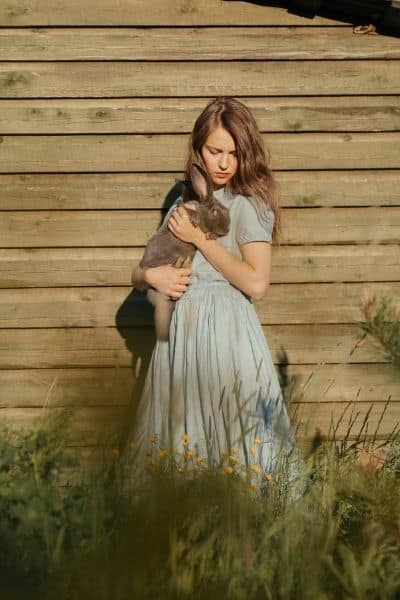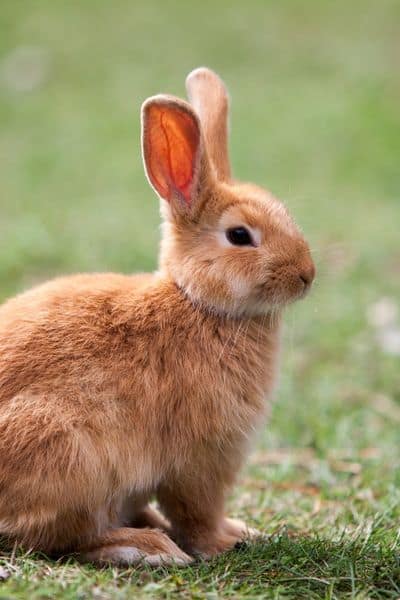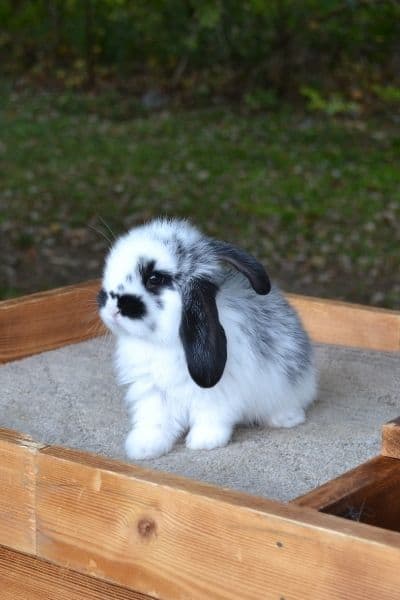7 Unique Tips To Choose The Best Rabbit Breed For Your Rabbitry
Choosing the best rabbit breed to raise in your rabbitry can be difficult. There are so many different breeds all with unique qualities and characteristics of their own.
It’s tempting to what to get all the cool breeds and see which one you like. I mean there are is the intriguing size of all the Giant rabbit breeds. The coat of the Chinchilla, the reserved nature of the Mini Lop, or the energizer bunny characteristics of the Netherland Dwarf.
I want to encourage you to only get one MAYBE two breeds to start with.
You only have so much space and you need a minimum of two rabbits to just try out a breed. Let alone to see if you actually like raising it and improving on the rabbits you have. If you have too many different breeds you won’t be able to have space and grow a stronger herd.
You will also struggle to stay focused on the animal’s body type and quality because you are trying to learn more than one breed at a time. It’s very difficult to study an animal and become so good at a breed it almost becomes instinctual.
I don’t want you to end up with 10 different breeds and a bit in over your head… so let’s think about some things first.
Before You Choose The Best Rabbit Breed For You – Think About This
Ask yourself these questions:
- What do you want out of your rabbitry?
- How much work are you willing to put into raising the rabbit?
- What does the coat require a lot of grooming that is going to take a lot of your time.
- Do you want more rabbits or are you willing to have a few larger ones. (cause let’s be real, giant breeds eat the same as about 3 smaller rabbits)
- What kind of quality do you want to raise? Do you want to do better than pet rabbit quality or do you want to get better animals than that?
Think About The Life You Want To Live Before You Choose A Rabbit Breed
Think about the life you want to live before you buy your rabbits. The more animals you bring to your farm or home you are narrowing your flexibility. Do you like to go on vacation a lot or go on spontaneous trips? Or do you leave a lot for work?
This is something that a lot of people don’t think about but having animals that are not as common as a dog or a cat. Yes you still have to arrange for care. But rabbits are different. It’s going to be difficult to find someone to care for them while you were on vacation or even leave on a day trip.
If you’re lucky you might be able to find someone who is willing to feed and water them but what if you have to leave and you have rabbits that are about to give birth... That is a whole nother ball game when you have to expect your house sitter to watch for newborn kits and make sure all goes well.
I had that happen on vacation and had three does due back home. Trust me that does not make for a relaxing time. The trip was not my idea but I caved and well the results back home were not the way I would have chosen.
Think About Your Local Weather Before You Choose The Best Rabbit Breed For You
How hot does it get where you are? What about the cold? Are you going to keep them outdoors, in a barn, or in rabbit hutches outside?
Your local weather and climate is also going to dictate the rabbit breed you should get. Giant (and chunky) rabbit breeds like the Flemish Giant, Giant Chinchilla, or even the smaller but thicker breeds like the Mini Lop all take heat very difficulty.
If you live in a cold-weather climate breeds like the Tan, Netherland Dwarf, Polish, and Dutch rabbit breeds are all very thin in both body and fur. They would not survive the winters of the northern states if they lived in a hutch outside.
Possible Income Or Uses
This is going to vary on your goals for your rabbitry BUT think about why you want to have rabbits in the first place. Which breeds meet the bulk of your goals or requirements.
Think about the market around you. Is the breed common and do you see a lot of people with them? Do you intend to sell them as pets or show rabbits are they providing your family with food or manure for your garden?
But think about other avenues of income are you able to create products around the rabbits that you could sell such as yarn or crocheted items from the wool. Or maybe you can create online education to teach people how to care for their pets.
How Much Space You Have
It’s pretty obvious that breeds are different in size. Buuuut there is also the different letter sizes and some breeds will grow faster than others. So think about the possible space that could take.
Also, think about the doe and litter size cages you would need.
It’s a good idea to have what I call “buffer” cages to keep rabbits in that are going to new homes. Life happens and sometimes buyers change their minds or take longer than expected to come pick up the rabbit.

Jr’s should only stay together until about 12 weeks old and then you need to start watching for fighting. Yes I know it’s hard to believe that those cute little faces would ever fuss at each other but if you leave two males together for too long it’s not going to be a pretty sight. The girls don’t tend to squabble as early but they too will not agree with each other after a few more weeks.
Free Farm Goal Planner!!!
➡️Get my proven system for choosing your farm goals so you don’t get burnt out.
Typical Cage Sizes
If you have cages already try to see if you are happy with a breed that will work in the cages you already have. Don’t spend more money if you don’t have to.
Here are cages sizes recommended by the ARBA but keep in mind these two things as well.
- Keep in mind that these are the guidelines but if your rabbit has more energy then maybe more space would be a good idea if you have it.
- Also, keep in mind that you can make these measurements to fit where you need them to. Your rabbit is not going to care if it is deeper than the recommended guidelines but not as wide.

Recommended cage size from the ARBA
Rabbits under 6lbs 18 deep, 24 wide, 12 inches high above 6 pounds but under 11lbs 24 deep, 26-36 wide, 18 inches high anything above 12lbs 24 deep, 36-48 wide, 18 inches high
Current Assets Of Your Rabbitry
When you’re deciding what rabbit breed is right for you to raise think about your assets. Do you have any cages already? What size are they? Are you going to have to buy all new cages to start the breed that you want?
What Is The Starting Price Of The Breed You Want
This might take some time to figure out but all breeds have different price ranges. There are several factors that will cause the price to go up or down.
The commonality of the breed is one thing that will cause the price to be broader. If there are a lot of the breed around then there are both good and very poor quality. Making it harder to find good quality animals and when you do find them. You will have to pay several hundred dollars.
Holland Lops are a perfect example. That breed of rabbit can go anywhere from $15 which will be extremely low quality and you might even question if it is a pure breed. Or as much as $150 – $300 that will be much better quality.
Californians are another example of this they be purchased for as cheap as $20 or even less sometimes. But I have also seen good quality meat rabbits go at auction for several thousand at our state convention.
So it all depends on the market you want to get into and how serious you are about it.
So just think about the amount you are willing to pay before you spend a lot of time looking and become disappointed.
Rabbitry Knowledge Assets To Help Choose The Right Breed
Think about your knowledge assets. If you are going to get serious about a breed you need someone to help you learn the quirks of the breed. Yes, every breed has them and the books don’t teach you what someone in the trenches can.
Who do you know that you can talk to about the breed when you have a question? And are you going to have to learn all about rabbits or is it going to be easy for you to get started?
Talk to breed owners. All breeds have their own quirks. French lops are not the easiest breed to have successful litters.
And this won’t always be possible but do your best to talk to a breeder or someone who has had the breed you were looking at before you buy. Keep your eyes and ears open. Most rabbit raisers will talk to you for days about their breed.
Best Way To Start With A New Breed
Start with a trio (two does and one buck). Unrelated animals if at all possible. That way if you want to keep some of the juniors you can. Now like I said can be tempting to want to go buy all the breeds but that’s not going to get you anywhere if you are trying to make an income.
Some Breeds To Think About
Here are some of the top breeds that I would recommend and shouldn’t be too hard to find. You can click through to the ARBA (American Rabbit Breeders Association) To find out more info on each of the breeds.

For Meat
What rabbit breeds are best for meat production?
Two medium-size breeds, the New Zealand White (NZW) and the Californian, are the most important for meat production. They have white fur that is difficult to see if a few pieces are stuck to the carcass, and they have higher meat-to-bone ratios. The NZW is considered the best breed overall, considering mothering ability and carcass characteristics.
Source: attra.ncat.org
Californian
Developed in Southern California in the 1920s by George West, the Californian is one of the most popular breeds of rabbits in the ARBA. Prized for its meat-producing qualities as well as its pelt, the “Cal” is a competitive commercial breed in all 50 states and beyond. – Maximum weight 10.5 lbs. Source: arba.net
New Zealand
With more ARBA Best in Show wins than any other breed, the New Zealand rabbit was a game changer for many breeders. Despite the name, the breed was originally developed in the United States and became recognized in 1916. New Zealands were prized for their quick growth rate and meat production, and while the Reds were initially more popular, the New Zealand White soon took over due to the easy of dyeing a white pelt for the fur market. – Maximum weight 12 lbs. Source: arba.net
Polish
The origins of the Polish remain somewhat obscure. The breed was mentioned in English literature in 1860 and was believed to have owed their origins to Britain and not Poland as their name suggested. Though diminutive in size, the Polish is not a dwarf breed, having longer ears, a non-brachycephalic head, and less cobbiness of body than the Netherland Dwarf. The Polish are a popular show rabbit and enjoy a loyal following among exhibitors. – Maximum weight 3.5 lbs. Source: arba.net
Smaller Breeds That Should Be Easier To Handle
American Fuzzy Lop
The American Fuzzy Lop became a recognized breed in 1989. Known for its lopped ears, large head, and wooled coat, the AFL is a sweet tempered, rabbit that is energetic and popular for beginning and seasoned exhibitors alike. – Maximum weight 4 lbs.
Source: arba.net
Holland Lop
Originally developed by Adriann de Cock of the Netherlands with the purpose of creating a dwarfed lop-eared rabbit that was smaller and easier to handle than the larger French Lop. The venture was long and challenging but ultimately, rewarding as the breed was recognized by the ARBA in 1979. Today the Holland Lop is one of the top five most popular breeds in the ARBA. Its compact size paired with the large head and lopped ears makes it a beautiful addition to the rabbit world. – Maximum weight 4 lbs.
Source: arba.net
Jersey Wooly
This distinctive breed with the mug head and luxurious wooled coat was developed by Bonnie Seeley and recognized as a breed in 1988. Bonnie’s intent was to produce a small pet rabbit with wool that was easy to care for. Today, the Jersey Wooly has become one of the most popular breeds of rabbit exhibited in the US and abroad. – Maximum weight 3.5 lbs.
Source: arba.net
Lionhead
The most eye-catching feature of the Lionhead rabbit is the distinctive mane around its head giving it the look of a male lion, as the name implies. While the Lionhead has only been a recognized breed in the United States since 2014, it is steadily gaining in popularity throughout the rabbit hobby. In 2018 the Lionhead roared; capturing its first ARBA Convention Best in Show! – Maximum weight 3.75 lbs.
Source: arba.net
Mini Lop
Stocky and compact the Mini Lop was brought to the U.S. in the 1970s bearing the name Klein Widderand. After a slow start and a name change, the Mini Lop (presented by Herb Dyck), became an official ARBA breed in 1980. Easily recognized by the softball-sized head and engaging lopped ears, the Mini Lop only gains in popularity each year. – Maximum weight 6.5 lbs.
Source: arba.net
Mini Rex
Though a relatively new breed, the Mini Rex is consistently the #1 or #2 top entry at any ARBA Convention. Developed in 1984 in Texas by the late-great Monna Berryhill. The plush coated Mini Rex became a recognized breed in 1988 and have been dominating the show tables ever since. Popular and available in may different colors, the Mini Rex appeals to both new and seasoned breeders. – Maximum weight 4.5 lbs.
Source: arba.net
I can tell you which rabbit breeds I think are the best but truth be told you are going to have to get down and dirty with your research. One of the most fun ways to see all the breeds possible is to go to a larger rabbit show. Most people don’t realize you can go to one without being a participant.
If raising rabbits is right for you. Seeing hundreds of rabbits in one place will light a fire under you that you never thought could be there.





